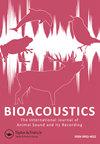自动识别鸟类鸣叫的软件性能:两个密切相关物种的案例
IF 2.1
4区 生物学
Q2 ZOOLOGY
Bioacoustics-The International Journal of Animal Sound and Its Recording
Pub Date : 2021-07-08
DOI:10.1080/09524622.2021.1945952
引用次数: 11
摘要
摘要:现在,自主录音单元可以方便地收集大量录音。然而,对大量声学数据的分析仍然是一个挑战。手动搜索鸟类发声所需的时间可能等于或大于音频记录的持续时间。通过使用为录音中鸟类发声的自动识别而开发的软件,可以显著减少这一主要限制。我们比较了四种软件(CallSeeker、Kaleidoscope Pro、Raven Pro和Song Scope)和卷积神经网络(CNN)的性能,使用的录音包括比克内尔画眉和灰颊画眉的叫声,以及其他鸟类的发声,这些鸟类的声学特征与我们的目标物种的声学特征重叠。我们根据两个主要标准对所有软件进行了评估,即它们检测叫声的能力和按物种正确分类的能力。软件性能在呼叫检测(召回)方面为30%至90%,在正确的呼叫分类(精度)方面为27%至99%。细胞神经网络为在嘈杂声景中检测动物发声这一长期存在的问题提供了一个很有前途的解决方案,同时消除了配置算法以最大限度地提高软件性能的繁琐手动步骤。本文章由计算机程序翻译,如有差异,请以英文原文为准。
Software performance for the automated identification of bird vocalisations: the case of two closely related species
ABSTRACT Autonomous recording units now facilitate the large collection of audio recordings. However, the analysis of large amounts of acoustic data remains a challenge. The time required for manually searching for bird vocalisations may be equivalent or greater to the duration of audio recordings. This major constraint can be significantly reduced through the use of software developed for automated identification of bird vocalisations in audio recordings. We have compared the performance of four software (CallSeeker, Kaleidoscope Pro, Raven Pro, and Song Scope) and a Convolutional Neural Network (CNN) using audio recordings containing calls of Bicknell’s Thrush and Gray-Cheeked Thrush, as well as the vocalisations of other bird species whose acoustic characteristics overlap with those of our target species. We evaluated all the software on the basis of two main criteria, their ability to detect calls and their ability to classify them correctly by species. Software performance ranged from 30 to 90% in terms of call detection (recall) and from 27 to 99% in terms of correct call classification (precision). CNNs offer a promising solution to the long-standing problem of detecting animal vocalisations in noisy soundscapes, while eliminating the tedious manual step of configuring the algorithms to maximise software performance.
求助全文
通过发布文献求助,成功后即可免费获取论文全文。
去求助
来源期刊
CiteScore
4.50
自引率
0.00%
发文量
25
审稿时长
>12 weeks
期刊介绍:
Bioacoustics primarily publishes high-quality original research papers and reviews on sound communication in birds, mammals, amphibians, reptiles, fish, insects and other invertebrates, including the following topics :
-Communication and related behaviour-
Sound production-
Hearing-
Ontogeny and learning-
Bioacoustics in taxonomy and systematics-
Impacts of noise-
Bioacoustics in environmental monitoring-
Identification techniques and applications-
Recording and analysis-
Equipment and techniques-
Ultrasound and infrasound-
Underwater sound-
Bioacoustical sound structures, patterns, variation and repertoires

 求助内容:
求助内容: 应助结果提醒方式:
应助结果提醒方式:


